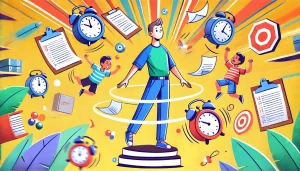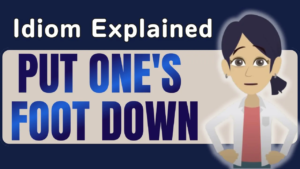Ever been told to “keep on your toes” and wondered if you needed to practice ballet?
To remain alert, vigilant, and ready to respond quickly to changing situations or challenges.
This common English idiom often confuses learners who picture themselves literally balancing on tiptoes. In reality, it’s about mental alertness and adaptability.

Whether in a fast-paced workplace or competitive sports, this expression captures the essence of staying prepared for whatever comes next.
Understanding this phrase will enhance your English fluency and help you communicate more naturally in various contexts.
New Hire’s First-Day Mix-Up
A fresh hire at a lively, fast-paced company once heard a seasoned colleague say, “This position will keep you on your toes.”
She glanced down at her shoes, thinking she might have to spend the day perched on her tiptoes.
Her literal interpretation quickly led to confusion, especially in a workplace where agility is not about ballet but rather about adapting to sudden demands.
The colleague soon explained that “keep you on your toes” refers to maintaining a state of readiness—no pointe shoes required.
Why This Case Study Matters
- Highlighting Common Misunderstandings: Idioms are often metaphorical. People unfamiliar with them may picture the phrase quite literally.
- Demonstrating the Importance of Context: A fast-paced company uses this idiom to stress being prepared for new tasks, deadlines, or changes.
- Encouraging Clear Communication: Once the new employee understood the idiom, she felt more confident and capable in responding to rapid shifts at work.
Grasping the Idiom’s Essence
The idiom “keep me on my toes” is all about readiness and attentiveness. Imagine standing slightly elevated on your toes, prepared to move at a moment’s notice.
Whether you’re working on an urgent project or engaging in sports, someone or something that keeps you on your toes challenges you to remain sharp and responsive.
Definition
To “keep someone on their toes” means to maintain vigilance and adaptability in unpredictable circumstances.
It could be a boss assigning new projects without warning, a basketball game where the strategy changes mid-court, or daily life when unexpected events pop up.
A Humorous Anecdote
A friend once misunderstood this idiom and took it literally. After being told, “This activity really keeps me on my toes,” he started standing on tiptoe during a work meeting, trying to demonstrate his enthusiasm.
Though it drew curious stares, it served as a memorable lesson: idioms often have figurative meanings rather than literal ones.
Common Scenarios
- Professional Environment: If you’re in a hectic office where duties shift quickly, staying on your toes ensures you never miss a crucial update.
- Sports and Athletics: A coach might say, “Stay on your toes,” meaning be quick and agile. Taking this too literally might lead to awkward tiptoe movements during a drill, missing the true point of staying mentally and physically prepared.
- Everyday Life: Even in daily routines, certain tasks can keep you on your toes—like juggling multiple errands or handling small surprises.
Interesting Origin (Note)
While the exact historical origin of “keep me on my toes” is not definitively traced to one source, many believe it borrows imagery from dance or sports.
Dancers, especially ballet dancers, must stay literally on their toes to execute moves gracefully. Athletes, too, often remain on the balls of their feet to spring into action.
These images likely combined to create the idea of readiness and mental alertness in everyday usage.
Practical Examples
Clear examples help solidify your understanding of this idiom. Below are scenarios showing how people commonly use “keep me on my toes” in both personal and professional contexts.
Work Context
- Example 1: “My new project really keeps me on my toes. One day I’m analyzing spreadsheets, and the next I’m leading a client meeting.”
- Misunderstanding: Assuming you need special shoes to do your job.
- Correct Understanding: The nature of the work requires quick thinking, adaptability, and mental agility.
- Example 2: “Handling unexpected assignments keeps me on my toes, which makes my job more exciting.”
- Misunderstanding: Imagining the role involves physical balancing.
- Correct Understanding: The phrase underlines staying prepared for anything, including last-minute changes.
Sports Context
- Example 1: “Our coach loves to keep us on our toes by introducing new drills every practice.”
- Misunderstanding: Believing the team has to practice ballet footwork.
- Correct Understanding: Recognizing that the coach wants players to be mentally and physically prepared, anticipating rapid shifts in strategy.
- Example 2: “Playing against a tough opponent always keeps me on my toes, because I never know what move they’ll make.”
- Misunderstanding: Thinking your stance literally has to be on your toes the entire game.
- Correct Understanding: Accepting that unpredictability demands constant vigilance.
Visualizing the Idiom Clearly
When you hear “keep me on my toes,” picture an individual lightly balanced at the edge of motion. This mental image embodies the idiom’s figurative meaning: staying focused and ready for whatever comes next.
Visualization Techniques
- Physical Readiness: Imagine yourself in a slight crouch, prepared to leap. This mindset underscores the idiom’s call for alertness.
- Mental Agility: In your mind, visualize scanning your environment for sudden changes. Just as dancers maintain form and readiness, so do people in high-pressure situations.
Idiom Memory Tips
- Create Mental Images: Form a quick picture in your head every time you read or hear “keep me on my toes.”
- Use in Context: Practice by constructing sentences relevant to your life, such as, “My family obligations keep me on my toes, since plans can change unexpectedly.”
- Revisit Often: The more you integrate this phrase into your daily language, the more naturally it will come to mind in conversations.
Another Case Study
Imagine you’re watching a basketball match that’s neck-and-neck. The coach shouts, “This game will keep us on our toes!”
In that heated moment, players understand the coach’s intention: they must remain hyper-alert, ready to seize any chance that arises.
This high-pressure environment brings the idiom to life, proving how vital it is to adjust instantly to ever-shifting dynamics.
Lessons from the Court
- Speed Matters: Whether in sports or at work, events can shift quickly. Being “on your toes” lets you react before opportunities pass.
- Team Coordination: When everyone remains alert, communication and timing are sharper, leading to better outcomes.
- Positive Stress: A bit of pressure can be beneficial, prompting teams or individuals to stay concentrated on the task.
Similar & Opposite
Similar Expressions
- Keep me alert: Emphasizes staying fully awake to changes, closely paralleling the idea of remaining vigilant.
- Keep me focused: Conveys the need for concentration and mental engagement, aligning with the core concept of “keep me on my toes.”
Opposite Expressions
- Let me relax: Signals a desire to step back, detaching from immediate tension or mental intensity.
- Let me unwind: Suggests a deliberate move away from being at high readiness, taking a moment to recharge instead.
These contrasting expressions deepen our grasp of the idiom’s essence. While “keep me on my toes” means remaining attentive, its opposites encourage rest and release of tension.
Pop Quiz: Check Your Idiom Skills
Keep Me on My Toes

Conclusion



Remember! When something ‘keeps you on your toes,’ it’s making you stay alert and ready. This idiom shows the value of adaptability in any situation!
Embracing this phrase in your English learning journey can boost your confidence, as you’ll better grasp the notion of remaining ready for life’s sudden twists.
Note on Correct Usage
“Keep me on my toes” is a figurative phrase—it doesn’t mean standing on tiptoe or only applies to sports or work. It refers to staying alert and adaptable in any situation.
Using idioms like this helps improve your English. This phrase highlights the importance of being attentive and ready for change.



Try using it in conversations about work, daily life, or personal challenges.
If you’ve experienced moments that kept you on your toes, feel free to share them. Real-life examples make idioms more memorable—and learning through reflection keeps us sharp!









Comment